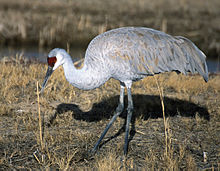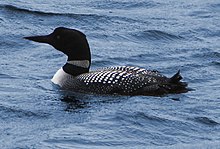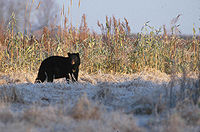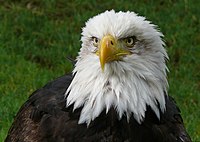Which Two Animals Were Instrumental In The Lives Of Native Americans?
The Anishinaabe, like most Algonquian-speaking groups in North America, base their arrangement of kinship on patrilineal clans or totems. The Ojibwe word for clan ( doodem ) was borrowed into English equally totem. The clans, based mainly on animals, were instrumental in traditional occupations, intertribal relations, and marriages. Today, the clan remains an important part of Anishinaabe identity.
Tradition [edit]
The Anishinaabe peoples are divided into a number of doodeman , or clans, (singular: doodem ) named mainly for brute totems (or doodem , every bit an Ojibwe person would say this word in English).[1] In Anishinaabemowin, ode' means heart. Doodem or clan literally would translate equally 'the expression of, or having to practice with one'due south heart'; in other words doodem refers to the extended family. According to oral tradition, the Anishinaabe were living along the Atlantic Body of water coast and the peachy Miigis beings appeared out the sea and taught the Mide fashion of life to the Waabanakiing peoples, vi of the seven corking Miigis beings that remained to teach established the odoodeman for the peoples in the east. The five original Anishinaabe totems were Wawaazisii (bullhead), Baswenaazhi (echo-maker, i.e., crane), Aan'aawenh (pintail duck), Nooke (tender, i.eastward., bear) and Moozwaanowe ("little" moose-tail).[2]
The meh established "a framework of government to give them strength and lodge"[three] in which each totem represents a core branch of cognition and responsibility essential to club. Today, half-dozen general totems compose this framework. The crane and the loon are the chiefs, responsible for over-seeing and leading the people. The fish are the scholars and thinkers and are responsible for solving disputes between the crane and the loon. The bear are both warriors and medicine gatherers. The martens are hunters but besides warriors besides. The moose are craftsman and artists. Clans are both a means of acquiring and retaining knowledge for the Anishinaabe. Cognition gained through experience and interactions with the Spirits and other clan members is passed down and built upon through generations.[4]
Traditionally, each band had a self-regulating council consisting of leaders of the communities' clans or odoodeman , with the ring frequently identified by the main doodem . In meeting others, the traditional greeting among the Ojibwe peoples is "What is your doodem ?" (" Aaniin odoodemaayan? ") in gild to plant a social conduct betwixt the two coming together parties as family. Marriage among members of the same clan is forbidden.[4]
Etymology [edit]
The word odoodem is a dependent noun. When speaking of one own doodem , the Anishinaabe would say nindoodem(-ag) ('my clan(s)'), gidoodem(-ag) ('your clan(s)') for addressees and odoodeman ('his/her clan(s)') for others. [5]
Educational activity [edit]
The clan system is an integral part of acquiring and retaining knowledge for the Anishinaabe. Each clan contributes a key element to the gild and individual members contribute to a clan's knowledge through feel. During a clan member'due south lifetime, they are able to gain knowledge known by the clan; emphasis is placed on personal experience, rather than a strict student-teacher human relationship. Although members learn through relationships with other association members, it is the experience gained as a result of these relationships that allows them to accomplish knowledge. Throughout a clan member'due south life, noesis they gain that was previously unknown to the clan is added to the association's collective knowledge.[six] This knowledge is then passed down to future generations, contributing to the "flow of Nebwakawin (wisdom) that passes from generation to generation".[7]
Despite pressure from the colonial society in Canada and the United States, much Anishinaabe cognition has survived and continues to exist shared and built upon. Alexander Wolfe's World Elder xviii Stories: The Pinayzitt Path, Dr. Dan Musqua'southward The 7 Fires: Teachings of the Bear Association, and Edward Benton-Banai'southward The Mishomis Book: The Vocalism of the Ojibway are a few notable works of Anishinaabe literature. These publications are of import carriers of knowledge that laissez passer from the ancestors to future generations.[6]
Clan totems [edit]
At that place were at least twenty-one Ojibwe totems in all, recorded by William Whipple Warren. Other recorders, such equally John Tanner, list many fewer but with dissimilar doodem types. For the Potawatomi, at to the lowest degree fifteen different totems were recorded. The association types today are quite all-encompassing, merely usually only a handful of odoodeman are found in each of the Anishinaabe communities. Like whatsoever other Algonquian groups, the Anishinaabe clan system served every bit a system of government as well equally a means of dividing labour. The v groups or phratries are listed below, listing each of the doodem clans or gentes within their group. The known Algonquin clans are marked with (Al), Mississauga clans with (Ms), Nipissing clans with (Ns), Ojibwa clans with (Oj), Odawa clans with (Od) and Potawatomi clans with (Po).
Bimaawidaasi grouping [edit]
The Bimaawidaasi group was charged with scouting, hunting and gathering.
- "Hooves" subdivision:
- Moozwaanowe ("Little" Moose-tail) (Oj)
- Moozens or Moozoons or Moozonii (Piddling Moose)
- Mooz (Moose) (Od, Oj)
- Adik (Caribou) (Al, Ms, Oj, Od) — The Adik totem is common amidst the Ojibwa and Oji-Cree north of Lake Superior. A prominent family from this doodem from the G Portage area relocated to La Pointe and produced the chiefs Mamongazeda and Waubojeeg. After members of this branch became leaders at Sault Ste. Marie.
- Waawaashkeshi (Deer) (Al, Ms)
- Mishewe (Elk) (Oj, Po)
- Omashkooz (Stag)
- Eshkan (Antler)
- Bizhiki (Buffalo) (Ms)
- "Little Paws" subdivision:
- Waabizheshi (Marten) (Oj)

This pictographic 1849 petition shows an Ojibwa principal represented by the Marten doodem.
- Amik(waa) (Beaver) (Ms, Ns, Oj, Od, Po)
- Wazhashk (Muskrat) (Oj)
- Gaag (Porcupine)
- Esiban (Raccoon)
- Waabooz(oo) (Rabbit) (Oj, Po)
- Zhaangweshi (Mink)
- Waagoshiinh (Play tricks) (Po)
- Zhigaag (Skunk) (Ms)
- Asanagoo (Squirrel) (Ns, Od)
- Waabizheshi (Marten) (Oj)
Giishkizhigwan group [edit]
The Giishkizhigwan group was charged with pedagogy and healing.
- Giigoonh or Namens (Fish)
- Wawaazisii or Owaazisii (Bullhead) (Oj, Od)
- Maanameg (Catfish) (Ms, Oj, Od)
- Adikameg (Whitefish) (Od)
- Namebin(aa) (Sucker) (Oj, Od, Po)
- Name or Maame (Sturgeon) (Oj, Po)
- Ginoozhe (Freeway) (Ms, Oj, Od)
- Mikinaak (Snapping turtle) (Oj)
- Mishiikenh (Mud turtle) (Oj, Po)
- Miskwaadesi (Painted turtle) (Oj)
- Ginebig (Snake) (Ms, Oj)
- Omazaandamo (Black snake) (Od)
- Midewewe or Ozhiishiigwe (Rattle snake),[viii] or Zhiishiigwaan (Rattle) (Al, Od)
- Omakakii (Frog) (Po)
- Nigig (Otter) (Ms, Od)
- Nibiinaabe (Merman)
- Ashaageshiinh (Crab) (Po)
Nooke group [edit]
The Nooke group was responsible for defense and healing. Though today the Bear Association has all merged into a single clan known as Nooke, at one time the Carry was the largest — so big, in fact, that information technology was sub-divided into body parts such as the head (Makoshtigwaan or 'bear-skull'), the ribs and the anxiety (Nookezid or 'tender-foot'), also equally different types of bears such as the Waabishki-makwa or 'white blackness deport' and the Mishimakwa or 'grizzly comport'.
- Makwa (Bear) (Ms, Oj, Od, Po)
- Makoshtigwaan (Conduct-skull)(Oj)
- Nookezid (Tender-foot)(Oj)
- Makokon (Behave'due south Liver) (Ms)
- Miskwaa'aa (Blood) (Ns)
- Waabishki-makwa (White black deport)(Oj)
- Mishimakwa (Grizzly bear)(Oj)
- Bizhiw (Lynx) (Oj, Od)
- Ma'iingan (Oj) or Mawii'aa (Po) (Wolf)
Baswenaazhi group [edit]
The Baswenaazhi group were traditionally charged with outgoing International communications. Because of this, ofttimes members of the Baswenaazhi group are said to be the virtually vocal.
- Binesi (Thunderbird)
- Ajijaak(we) (Crane or "Thunder") (Ms, Oj, Od, Po)
- Nesawaakwaad ("Forked tree") (Od)
- Ashagi (Heron) (Ns)
- Gekek (Hawk) (Oj, Od)
- Omigizi(we) (Baldheaded eagle) (Ms, Oj, Od, Po)
- Mitigomizh (White oak) (Ms)
- Wiigwaas (Birch bark) (Ms, Ns)
- Giniw (Golden eagle) (Po)
- Bibiigiwizens (Sparrowhawk)(Od)
- Makade-gekek(nosotros) (Black hawk) (Po)
- Ajijaak(we) (Crane or "Thunder") (Ms, Oj, Od, Po)
Bemaangik group [edit]
The Bemaangik are charged with internal/domestic communications. They were oftentimes charged with the community'southward own council fires and help facilitate dialogue on all internal/domestic issues.
- Bineshiinh (Bird)
- Aan'aawenh, Aa'aawenh or Aa'aawe (Pintail) (Oj)
- Owewe (Wild goose or "Swan")
- Bine (Partridge or "turkey") or Aagask (grouse) (Oj, Po)
- Nika (Goose) (Ms, Oj)
- Maang (Loon) (Al, Oj, Od, Po)
- (Makade)Zhiishiib ((Black) duck) (Oj)
- Gayaashk (Gull) (Oj, Od)
- Jiwiiskwiiskiwe (Snipe) (Oj)
- Omooshka'oozi (Bittern) (Oj)
- Zhedeg (Pelican)
- Ogiishkimanisii (Kingfisher) (Al, Oj)
- Aandeg (Crow) (Po)
- Gaagaagishiinh (Raven)
- Omiimii (Dove) (Ms)
- Apishi-gaagaagi (Magpie) (Ms)
Metaphors [edit]
On occasion, instead of referring to the totem by the actual being's name, a clan is identified instead by a metaphor describing the characteristic of the association's totem. The metaphors that survive to today include:
- Bimaawidaasi 'Carrier' = Amik(we) 'Beaver'
- Giishkizhigwan 'Cut-tail' = Maanameg 'Catfish'
- Nooke 'Tender' = Makwa 'Bear'
- Baswenaazhi 'Echo-maker' = Ajijaak(we) 'Crane'
- Bemaangik 'Pass-by Sounder' = Owewe 'Wild goose'
[edit]
Some national sub-divisions were but referred by their major association component. An example of this would be Maandawe-doodem ('Fisher-clan') of the Meshkwahkihaki peoples, who alive along the s shore of Lake Superior. More inland than the Maandawe-doodem were the Waagosh-doodem ('Fox clan') of the Meshkwahkihaki, who are called the Trick Tribe in English. When the Maandawe were defeated in a major battle between the Ojibwe and the Meshkwahkihaki peoples, the surviving Maandawe were adopted every bit part of the Ojibwa nation, but instead as the Waabizheshi-doodem ('Marten association'). Amid some Ojibwe people, (though not all) the Waabizheshi clan is likewise used to denote a form of adoption, i.e., a non-native father and Ojibwe mother. In other instances, for example, odoodem communities such as the Amikwaa were treated as fully interdependent Nations of the Anishinaabeg Confederacy, or given a designation to represent their master function in the social society, such equally with the Manoominikeshiinyag ('Ricing-rails') or the Waawaashkeshi-ininiwag ('Deer[-clan] Men').
Some doodem indicate non-Ojibwe origins. Other than Waabizheshi, these include the Ogiishkimanisii-doodem (Kingfisher Clan) and Ma'iingan-doodem (Wolf Clan) for Dakota and Migizi-doodem (Eagle Clan) for Americans. There are other odoodem considered rare today amongst the Ojibwa because the odoodem have migrated into other tribes, such every bit the Nibiinaabe-doodem (Merman Clan), which shows up every bit the Water-spirits Clan of the Winnebagoes.
Kinship [edit]
Ojibwa understanding of kinship is circuitous, taking into account of not only the immediate family but also the extended family. It is considered a modified Bisect merging (Iroquois) kinship system. Consequently, Ojibwa would speak of not only about grandfather ( nimishoomis ) and grandmother ( nookomis ), father ( noos ) and mother ( ningashi ), and son ( ningozis ) and daughter ( nindaanis ), but likewise would speak of elder brother ( nisayenh ), younger sibling ( nishiimenh ), cross-uncle ( nizhishenh ), parallel-aunt ( ninooshenh ), male sibling of same gender ( niikaanis ), female sibling of same gender ( niidigikoonh ) and sibling of opposite gender ( nindawemaa ), and cross-cousin of the opposite gender ( niinimoshenh ), to name but a few.
Siblings generally share the same term with parallel-cousins as with any Bifurcate merging kinship system due to being a fellow member the same doodem , but the modified organization allows for younger sibling to share the aforementioned kinship term with younger cross-cousins ( nishiimenh ). In improver the complexity wanes every bit ane goes away from the speaker's immediate generation, with some degree of complexity retained with female person relatives (for example, ninooshenh is 'my mother'south sister' or 'my begetter'south sister-in-constabulary'—i.due east., my parallel-aunt—but as well 'my parent'south female cross-cousin'). In both with the bang-up-grandparents and older generations and with the great-grandchildren and younger generations, the Ojibwa collectively call them aanikoobijigan . This sign of kinship/clans speaks of the very nature of the Anishinaabe's entire philosophy/lifestyle, that is of interconnectedness and balance between all living generations and all generations of the past and of the future.
In addition to the Anishinaabeg doodem , clans of other tribes are considered related to the Anishinaabe clans if they have the same designation. Consequently, for case, a marriage between an Anishinaabe Behave Clan member with a Cherokee Bear Clan member would be considered illegal — even incestuous — past many traditional customs groups.

Notable [edit]
White Crane [edit]

The White Crane association were the traditional hereditary chiefs of the Ojibwe at Sault Ste. Marie and Madeline Island, and were some of the more powerful chiefs encountered by the offset French explorers of Lake Superior. Members of the crane clan include:
- Tagwagane – an important chief at Madeline Island in the early 19th century
- Ikwesewe – the wife of Michel Cadotte and the namesake of Madeline Island
Loon [edit]

Closely associated with the crane clan, members of the loon clan became of import chiefs on Lake Superior's south shore during the fur trade period. Members of the loon clan include:
- Chief Buffalo – a famous chief of Madeline Isle
- Walter Bresette – a Red Cliff Ojibwe activist
Bear [edit]

Ever the most numerous of the Anishinaabeg, members of the bear clan were traditionally the warriors and police (Ogichidaa), too equally the healers. Many members of the association continue in these roles today. The behave clan provided most of those who participated in the Bad River Train Blockade. In fiction, the police officers in the novels of Louise Erdrich come from the deport clan.
Hawkeye [edit]

At present one of the most common clans, the eagle totem was one time of the smaller clans. Withal, the number of hawkeye totem members grew when new members whose paternal ancestors were Americans were assigned to this totem. Since the first sustained contact past the Anishinaabe with the Usa was through regime officials, the symbol of the American eagle was taken for a clan marking. Members of the Eagle clan include:
- William Whipple Warren – a 19th-century Ojibwe historian
- Nahnebahwequa – Mississauga Ojibway missionary and spokeswoman
- Kahkewaquonaby – Mississauga Ojibway Methodist missionary and spokeswoman
- Anton Treuer – Leech Lake Band Ojibwe historian and language activist
External links [edit]
- Nindoodemag: The Significance of Algonquian Kinship Networks in the Eastern Nifty Lakes Region, 1600–1701
- Aboriginal totem signatures, the Slap-up Peace of Montreal, 1701
- DEEDS / NATIONS — Directory of First Nations Individuals in South-Western Ontario 1750 - 1850 by Greg Curnoe, showing some treaty-signatory doodem
- Introduction to Kinship Terms by Dr. J. Rand Valentine.
References [edit]
- ^ WiLLMoTT, C. (2016). Anishinaabe Doodem Pictographs: narrative inscriptions and identities. Together We Survive: Ethnographic Intuitions, Friendships, and Conversations.
- ^ Bohaker, H. (2010). Anishinaabe Toodaims: Contexts for politics, kinship, and identity in the Eastern Great Lakes. Gathering places: Aboriginal and fur trade histories.
- ^ Acoose Miskwonigeesikokwe, J. (2011). "Minjimendaamowinon" anishinaabe reading and righting all our relations in written english
- ^ a b Flocken, G. H. (2013). An analysis of traditional ojibwe ceremonious primary leadership
- ^ Ojibwe People's Lexicon https://ojibwe.lib.umn.edu/main-entry/doodem-nad
- ^ a b Chartrand, R. (2012). Anishinaabe education. Canadian Journal of Native Education.
- ^ Acoose Miskwonigeesikokwe, J. (2011). "Minjimendaamowinon" anishinaabe reading and righting all our relations in written english
- ^ Older maps listing the Ozhiishiigwe equally either "Achiligoue" or "Chiligoue"
- Benton-Banai, Edward. (1979) The Mishoomis Book.
- Hilger, M. Inez. (1951) Chippewa Kid Life and Its Cultural Background.
- Johnson, Basil. (1990) Ojibway Heritage.
- Tanner, John. (1830) A narrative of the captivity and adventures of John Tanner, (U.S. interpreter at the Saut de Ste. Marie,) during thirty years residence among the Indians in the interior of North America, ed. Edwin James.
- Warren, William Due west. (1851) History of the Ojibway People.
- Mooney and Thomas. (1910) Handbook of American Indians Northward of United mexican states.
Source: https://en.wikipedia.org/wiki/Anishinaabe_clan_system
Posted by: danielalmom1995.blogspot.com

0 Response to "Which Two Animals Were Instrumental In The Lives Of Native Americans?"
Post a Comment